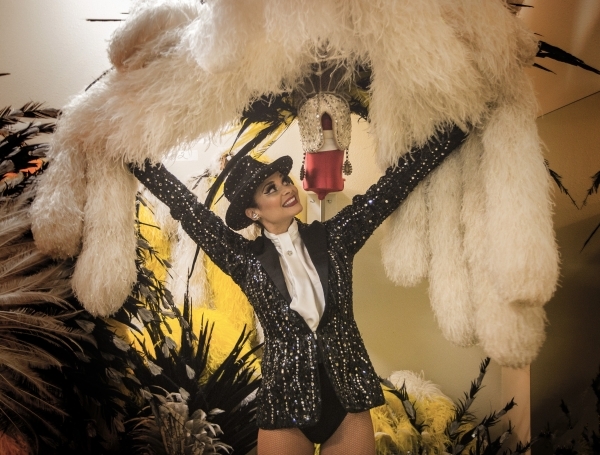Thursday February 20, 2020 10:15 am (Partially lucid, hyonogoggic)
The Vegas Glitter Queen
I am watching a young woman perform. She is in along limousine. She has arrived at her destination and is preparring to exiting the vehicle and make an entrance. There is no immediate special event, but she has planned every moment. She has on fabulous makeup and her outfit is black with many sequins. Her top is a short jacket with lapels that are stiff and stick out. She has crisply styled jet black shortly clipped hair. She is wearing shoes that she bought two pair and discarded one of each to get the look she wanted. She steps out and checks herself out in a full length mirror at the entrance to the venue.
I am talking with the driver as we are both impressed with the level of effort and skill that has gone into her preparation. The driver is a friend I know in waking life, D.G. We both want to help. There is a small step stool that I put one foot on and it slides across the front floor of the vehicle until I am at almost full splits (
a move that would put me in the hospital at the moment). We discuss a GoFundMe page for her. I am trying to get a good look at her face to figure out who she is. I am also very curious about her motivation and ask her about it.
I see her face clearly but do not recognize her. She tells me that her motivation is to show her kid how
you can become anything you put your mind to. An astronaut,a a scientist...whatever.
Notes: Not as intense as full lucid dream, but I was aware I was dreaming and making decisions; "I want to see her face and "why is she doing this?" Similar to scenarios created by Robert Moss in his class.
What does the dream want? For me to become my fully expressed self.
Reality Check: No so much...but pay attention for synchronicity.
Bumper Sticker:
Manifest Destiny
Dreams to Action: Get snowmobile & electric piano? Or is that spending shadow?
FYI: The hypnopompic state (or hypnopompia) is the state of consciousness leading out of sleep, a term coined by the psychical researcher Frederic Myers. Its mirror is the hypnagogic state at sleep onset; though often conflated, the two states are not identical. The hypnagogic state is rational waking cognition trying to make sense of non-linear images and associations; the hypnopompic state is emotional and credulous dreaming cognition trying to make sense of real world stolidity. They have a different phenomenological character.
Hypnagogia, also referred to as "hypnagogic hallucinations", is the experience of the transitional state from wakefulness to sleep: the hypnagogic state of consciousness, during the onset of sleep (for the transitional state from sleep to wakefulness see hypnopompic). Mental phenomena that may occur during this "threshold consciousness" phase include hallucinations, lucid thought, lucid dreaming, and sleep paralysis. The latter two phenomena are themselves separate sleep conditions that are sometimes experienced during the hypnagogic state.
:
The word hypnagogia is sometimes used in a restricted sense to refer to the onset of sleep, and contrasted with hypnopompia, Frederic Myers's term for waking up.[2] However, hypnagogia is also regularly employed in a more general sense that covers both falling asleep and waking up, and Havelock Ellis has questioned the need for separate terms.[3] Indeed, it is not always possible in practice to assign a particular episode of any given phenomenon to one or the other, given that the same kinds of experience occur in both, and that people may drift in and out of sleep. In this article hypnagogia will be used in the broader sense, unless otherwise stated or implied.
Other terms for hypnagogia, in one or both senses, that have been proposed include "presomnal" or "anthypnic sensations", "visions of half-sleep", "oneirogogic images" and "phantasmata",[3] "the borderland of sleep", "praedormitium",[4] "borderland state", "half-dream state", "pre-dream condition",[5] "sleep onset dreams",[6] "dreamlets",[7] and "wakefulness-sleep transition" (WST).[8]
Threshold consciousness (commonly called "half-asleep" or "half-awake", or "mind awake body asleep") describes the same mental state of someone who is moving towards sleep or wakefulness, but has not yet completed the transition. Such transitions are usually brief, but can be extended by sleep disturbance or deliberate induction, for example during meditation.[citation needed]
Frederic William Henry Myers (6 February 1843 – 17 January 1901) was a poet, classicist, philologist, and a founder of the Society for Psychical Research.[1] Myers' work on psychical research and his ideas about a "subliminal self" were influential in his time, but have not been accepted by the scientific community.[
Myers wrote a small collection of essays, Science and a Future Life which was published in 1893. In 1903, after Myers's death, Human Personality and Its Survival of Bodily Death was compiled and published. This work comprises two large volumes at 1,360 pages in length and presents an overview of Myers's research into the unconscious mind.[26][58][59] Myers believed that a theory of consciousness must be part of a unified model of mind which derives from the full range of human experience, including not only normal psychological phenomena but also a wide variety of abnormal and "supernormal" phenomena.[58][59] In the book, Myers believed he had provided evidence for the existence of the soul and survival of personality after death. The book cites cases of automatic writing, hypnotism, mediumship, possession, psychokinesis, and telepathy.[60]





